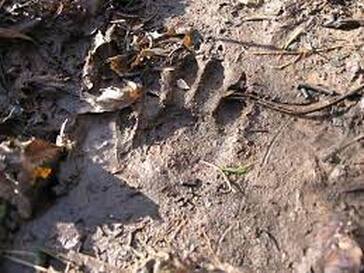From the Wilderness to the Boardroom: Unveiling Leadership Insights through Nature Tracking11/13/2023  My father instilled in me a love of the outdoors early on. It started with watching birds. Once I was old enough, it progressed to fishing and hunting on tanks, ponds and lakes in Northeast Texas. Dad became a marksman while in the Marine Corps. He manned a 50-caliber machine gun as a rear gunner on a Helldiver bomber while stationed on the Ulithi Atoll in the Pacific Theater. On many occasions I saw him down a duck or a Mourning Dove with a single shotgun blast. It was the pursuit of these activities and the quality time spent together that mattered more than the game or fish harvested. I can still remember many a morning when he woke me at 4 am to join him on an outing. As we drove to our destination, the headlights of our car knifing through the darkness, I still recall the scent of his Mennan after shave and the Camel cigarette smoke drifting through the car. Those were special days. Dad was a mystery most of his life, but he was in his element in the outdoors. When the opportunity came years later to take a course in outdoor survival, I registered immediately. As a part of this work, I was intrigued by the study and interpretation of tracks (footprints) and other signs animals leave behind in the wilderness. Tracking identifies the animal that left behind the footprints, scrapes, chews, digs and scat (animal waste) for us to see, and it grows into an understanding of the intimate details of that animal’s life. Some, like me, have taken the lessons of animal tracking and applied them to their study of human behavior in the wilds of the corporate world. A favorite Wall Street Journal article many years ago centered on this very topic. Animal tracking offers valuable lessons about people, particularly in the context of leadership, employee engagement, and crisis communication. Let's delve deeper into how we can identify human behaviors in ways similar to tracking animals, through stories and examples: Tracking Patterns in the Workplace Imagine a scenario where an organization is experiencing high turnover among its junior employees. Just as animal trackers look for patterns in footprints and other signs to identify species, leaders can analyze workplace data to identify patterns. They might discover that the turnover is higher among employees in a particular department, or after a specific event, such as a change in leadership or a merger. Key Takeaway: Similar to tracking animal movements, leaders must track patterns in employee behavior to uncover underlying issues affecting engagement and retention. Once identified, they can take targeted action to address these issues. Body Language and Non-Verbal Cues Picture a manager giving a presentation to their team. Some team members are engaged and nodding, while others appear disinterested, with crossed arms and blank expressions. Just as animal trackers observe non-verbal cues like body language to understand an animal's mood or intent, leaders should pay attention to their team's non-verbal cues. These cues can reveal their level of engagement, satisfaction, or discomfort. Key Learning: Effective leaders use their observational skills to adjust their communication style and address concerns when they notice non-verbal cues signaling potential issues. By doing so, they can maintain a more engaged and cohesive team. Listening Like a Tracker Imagine a CEO who regularly holds town hall meetings with employees but always dominates the conversation, rarely allowing employees to speak up. Or they refuse to take any questions but those that have been submitted in advance for which they have a “canned” response. Similar to how animal trackers listen for the faintest sounds in the wilderness, leaders should actively listen to their employees. Encouraging open dialogue and feedback is essential for understanding their needs, concerns, and ideas. Key Takeaway: Leaders who truly listen can identify early warning signs of dissatisfaction or discontent among employees. By fostering an environment where employees feel heard, leaders can improve engagement and prevent issues from escalating into crises. Crisis Communication and Tracking Signals Consider a company facing a public relations crisis due to a product recall. The initial response is vague and lacks transparency, leading to a wave of negative media coverage. In crisis communication, like tracking animal behavior during challenging situations, it's essential to monitor signals such as media coverage, social media sentiment, and customer feedback. These signals provide insights into the severity of the crisis and public perception. Key Takeaway: Just as animal trackers adapt their strategies based on signals in the environment, crisis communication specialists must adjust their approach in real-time. Transparent and timely communication can help mitigate reputational damage and rebuild trust. Adapting to Change Imagine a team struggling to adapt to new technology introduced by their organization. Some employees embrace it, while others resist the change. Similar to how animals adapt to changes in their habitat, employees must adapt to organizational changes. Leaders should identify resistance and offer support and training to facilitate a smoother transition. Key Takeaway: Effective leadership involves recognizing and addressing resistance to change, ensuring that the team adapts positively to new circumstances. Just as animal trackers help species adapt to evolving environments, leaders guide their teams through transitions. Being able to pivot and adjust strategies in response to challenges is a valuable skill. In the wilds of nature, I’ve learned that tracking goes beyond footprints and signs; it unveils the intricate details of an animal's life. Likewise, in the corporate jungle, tracking human behavior reveals the subtleties of leadership, engagement, and crisis communication. The lessons from my father's love for the outdoors and the wisdom of tracking have led me to understand that, just as animals adapt to their changing environments, effective leaders must adapt and guide their teams through transformations. So, whether in the wilds or the boardroom, remember that the pursuit of knowledge and the quality of time spent together matter most. Embrace these insights from nature, and let them guide you in your journey toward successful leadership and engagement.
1 Comment
Bruce Keith Berger
11/13/2023 04:42:36 pm
Great story, and spot on.
Reply
Leave a Reply. |
AuthorInsights from Keith Burton on leadership, mentoring, corporate culture and strategic employee engagement. Archives
May 2024
Categories |

 RSS Feed
RSS Feed